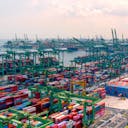The DCSA, BIMCO, FIATA, the ICC and SWIFT recently formed the Future International Trade (FIT) Alliance and signed a memorandum of understanding to help standardise the digitalisation of international trade.
In a series of articles, we are speaking to the FIT Alliance members to uncover what the Alliance means to them and how it will benefit international shipping. You can read the thoughts of Thomas Bagge, DCSA CEO and here, we get the carriers’ view from Grant Hunter, Director for Standards, Innovation and Research at BIMCO. We began by asking Grant:Why did BIMCO join the FIT Alliance?
Grant (G): We joined primarily because we believe that unity is strength, and we can see the benefit of working together with other large organisations. We are a member organisation of ship owners and people working in the shipping industry including ship brokers and agents, and so we know the benefits of strong membership.By partnering with other organisations, we believe we can deliver a stronger message and move electronic bills of lading ahead in a way that hasn’t been possible in the past quarter century or so. I like to call it a ‘coalition of the willing,’ as big industry bodies and associations are driving this issue forward now with some considerable momentum. We believe that BIMCO has an important role to play in assisting with the digital transformation of the shipping industry.What top three benefits do you see the FIT Alliance bringing?
G: Managing risk, making the whole process faster and more efficient, and reducing costs. We’re focused on electronic bills of lading (eBLs) because the bill of lading (B/L) plays a vital role in international trade. This document, which provides evidence of title to goods shipped, has been just a piece of paper for hundreds of years. To this day, it is still a piece of paper in 99% of world trade, and that’s an insecure way of doing something. Handling and processing pieces of paper is time consuming and labour intensive and paper bills can be lost and can be subject to fraud. That creates unnecessary risk in the industry which can be resolved by digitalising the whole process.Digitalisation will also make the process much faster because, at the moment, quite often a ship will arrive at the port where the cargo is to be unloaded before the paper B/L arrives. If the person who is there to receive the cargo cannot hand over the B/L, so what happens? Invariably some sort of letter of indemnity is issued to the shipowners, which essentially means them accepting a risk. A risk which is unnecessary if the genuine B/L can be there, delivered electronically.What, in your view, does the Alliance mean for international shipping and trade as a whole?
G: It’s important for the industry to know that all stakeholders involved in this digitalisation process are behind it, so it’s not, for example, just because the people who provide platforms or BIMCO say it’s a good idea. It’s everyone, the banks and the finance houses and the commodity traders as well as the owners and charterers of ships. That cohesive approach is only going to come through a big alliance like this – one that learns from other sectors that have already digitalised. Together, we can do it, but individually we may struggle.Is that united front also important when it comes to regulation?
G: There is a lot of regulatory work going on to give legal recognition to eBLs in jurisdictions around the world. That is a long-term goal, but it will take time to change laws, and it will cost money, so it won’t happen unless businesses can demonstrate they’re using or are prepared to use eBLs. Currently, something like less than 1% of world trade relies on eBLs. We must substantially increase that amount to help persuade governments to make the push to change legislation. We, as an industry, can’t sit back and wait for it to happen, we have to show that we want this now.The shipping landscape is complex, with many stakeholders, how can the FIT Alliance bring about change?
G: Open standards are key. Closed “proprietary” systems aren’t going to move the industry forward, so we need to come out as an Alliance and all agree on open standards. Open standards for B/Ls and interoperability standards as well. Right now, private platforms providing eBL solutions can’t communicate with each other so you can’t start a B/L on one platform and transfer it to another one. That means banks, handling eBLs for finance purposes, are faced with subscribing to multiple systems and training their staff to use each of them.We often get asked if we’re favouring one particular technology over another and we’re not. We’re technology-agnostic. As long as the standards are good, and we have interoperability, we don’t need to focus on the technology. The market will decide what system best suits their needs.
Digitalise the container shipping industry
At DCSA, we envisage a digitally interconnected container shipping industry in which customers have a choice of seamless, easy-to-use services that provide the flexibility to meet their business and sustainability goals.









